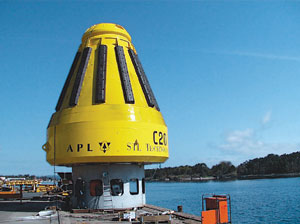 Technology from Europe: Technology from Europe:
Norway/Finland
First offshore LNG deepwater port buoy to be classified
ABS' classification services are helping to make the industry's first step toward offshore LNG development safe and efficient. On behalf of Norway's Advanced Production and Loading AS (APL), ABS will provide classification services for APL's Submerged Turret Loading (STL) system. The proprietary device is a single-point mooring system (SPM) and an integral component of the first offshore LNG terminal destined for the Gulf of Mexico, roughly 115 mi offshore Louisiana.
 |
An STL buoy similar to this one installed at Norway's Heidrun field will be classified for use at the US deepwater LNG terminal, offshore Louisiana.
|
|
The project will create industry's first offshore, deepwater LNG terminal in the US and will be the first of its kind in the world, said William J. Sember, ABS vice president of Energy Development. “This effort is aiding industry operators to reach new thresholds of LNG capability while addressing escalating gas demand, particularly in the US market,” said Sember.
Named the Energy Bridge Deepwater Port, the terminal system is planned for installation on West Cameron Block 603 in 280 ft of water. It incorporates APL's STL technology that is commonly used in the offloading of oil in such regions as the North Sea, offshore China and offshore Western Australia. First cargo for the port is scheduled for January 2005.
ABS has classed about 40 SPMs worldwide, but this project is markedly different. Sember said this project provides an industry model for taking traditional, land-based LNG receiving terminals offshore, to achieve environmental advantages and economies of scale for global gas trading.
“Offshore gas ports, such as the Energy Bridge Deepwater Port, will avoid many of the challenges associated with building or expanding conventional terminals in environmentally sensitive or populated areas, while facilitating the delivery of re-gasified LNG directly into pipeline grids,” said Sember.
The terminal will consist of the STL system, a new-build, piled platform to support a gas-custody transfer metering station, and associated pipelines connecting the STL system to two pipeline grids.
To be classed by ABS as A1 Single-Point Mooring (SPM), the (STL) buoy is under construction at Junoverken AB in Uddevalla, Sweden. It will be transported to US waters this November. The 186-t unit will allow specially built LNG carriers fitted with onboard re-gasification equipment to transfer gas through the buoy, which is connected to a pipeline end manifold (PLEM) on the seafloor.
The new carriers, known as Energy Bridge re-gasification vessels or EBRVs, are equipped with small moonpools to accommodate the STL buoy connection, but they retain the flexibility to trade as conventional LNG carriers. Two EBRVs are under construction at Daewoo Shipbuilding & Marine Engineering in South Korea. The first of these is due for delivery in November, with the second due in April 2005.
The STL buoy, planned for 298 ft of water, will float at a submerged depth of 90 ft at the top of the buoy. “Because of the inherent mobility of the Energy Bridge concept incorporating the novel use of the STL mooring and loading buoy, the system can be deployed virtually anywhere in the world to meet incremental demand for natural gas,” said Sember.
The plan for product transfer calls for one of the dedicated carriers to connect to the underwater buoy and export gas to the PLEM. The gas then flows to a 20-in., 1.9-mi pipeline to the platform metering station. From the platform, the gas routes into an existing network of underwater, high-pressure pipelines to shore.
The Energy Bridge Deepwater Port project, with planned capacity to deliver base load gas volumes in excess of 500 MMcfd, is scheduled to complete in January 2005. ABS' scope of work in this effort encompasses the submerged turret loading buoy; the mooring system for the buoy; and the riser to take the gas from the buoy to the PLEM. 
|

 Technology from Europe:
Technology from Europe:

